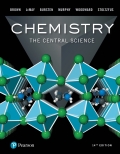
Concept explainers
(a)
To determine: The maximum number of coordination sites that the ligand ethylenediamine
(b)
To determine: The maximum number of coordination sites that the ligand bipyridine
(c)
To determine: The maximum number of coordination sites that the ligand oxalate anion
(d)
To determine: The maximum number of coordination sites that the ligand
(e)
To determine: The maximum number of coordination sites that the ligand
Want to see the full answer?
Check out a sample textbook solution
Chapter 23 Solutions
EBK CHEMISTRY:CENTRAL SCIENCE
- aw the major substitution products you would expect for the reaction shown below. If substitution would not occur at a significant rate under these conditions, check the box underneath the drawing area instead. Be sure you use wedge and dash bonds where necessary, for example to distinguish between major products. Note for advanced students: you can assume that the reaction mixture is heated mildly, somewhat above room temperature, but strong heat or reflux is not used. B C Br HO O Substitution will not occur at a significant rate. Explanation Check + Х Click and drag to start drawing a structure. © 2025 McGraw Hill LLC. All Rights Reserved. Terms of Use | Privacy Center | Accessibarrow_forwardComplete the following reactions with the necessary reagents to complete the shown transformation. Example: 1. 2. ? 3. 018 Br OH Answer: H₂O, H2SO4, HgSO4arrow_forward7:34 • < Question 18 of 22 5G 50% Submit What is the pH of a buffer made from 0.220 mol of HCNO (Ka = 3.5 × 10-4) and 0.410 mol of NaCNO in 2.0 L of solution? 1 2 3 ☑ 4 5 6 C 7 8 | 9 +/- 0 ×10 Tap here for additional resources ||| Гarrow_forward
- 6:46 ✔ 5G 58% < Question 7 of 22 Submit What is the primary species in solution at the halfway point in a titration of NH3 with HBr? A NH3 and H+ B NH₁+ and H+ C NH4+ D NH3 and NH4+ Tap here for additional resources |||arrow_forward6:49 Dji < Question 15 of 22 4G 57% Submit The pOH of a solution is 10.50. What is the OH- concentration in the solution? A 3.2 × 10-4 M B C 3.2 x 10-11 M 10.50 M D 4.2 M E 3.50 M Tap here for additional resources |||arrow_forwardヨ 6:49 Dji < Question 13 of 22 5G 57% Submit The pH of a solution is 2.40. What is the H+ concentration in the solution? A B 2.5 x 10-12 M 4.0 × 10-3 M C 2.40 M D 4.76 M 11.60 M Tap here for additional resources |||arrow_forward
- ヨ C 6:48 Di✔ < Question 12 of 22 5G 57% Submit The pH of a solution is 12.50. What is the H+ concentration in the solution? A 0.032 M B 3.2 × 10-13 M 1.5 M D 9.25 M 12.50 M Tap here for additional resources |||arrow_forwardヨ C 6:48 Di✔ < Question 11 of 22 5G 57% Submit The pH of a solution is 1.50. What is the H+ concentration in the solution? A 0.032 M B 3.2 × 10-13 M 1.5 M D 2.15 M 12.50 M Tap here for additional resources |||arrow_forwardSelect the product of the following reaction. Lon HO Meat ?? CH₂OH OH A D OH OCH B OH of OCH of CH חח E C CHarrow_forward
- Please correct answer and don't used hand raitingarrow_forwardPlease correct answer and don't used hand raitingarrow_forwardUse excel to plot the following titration data. Once you have done your plot, make sure to label the axes correctly. Use your graph to determine the pK, for the weak acid. Attach your plot to the back of this worksheet. A 1.0M solution of weak acid was titrated with a base and the following data was collected. Equivalents of Base pH observed 0.05 3.4 0.15 3.9 0.25 4.2 0.40 4.5 0.60 4.9 0.75 5.2 0.85 5.4 0.95 6.0arrow_forward
 ChemistryChemistryISBN:9781305957404Author:Steven S. Zumdahl, Susan A. Zumdahl, Donald J. DeCostePublisher:Cengage Learning
ChemistryChemistryISBN:9781305957404Author:Steven S. Zumdahl, Susan A. Zumdahl, Donald J. DeCostePublisher:Cengage Learning ChemistryChemistryISBN:9781259911156Author:Raymond Chang Dr., Jason Overby ProfessorPublisher:McGraw-Hill Education
ChemistryChemistryISBN:9781259911156Author:Raymond Chang Dr., Jason Overby ProfessorPublisher:McGraw-Hill Education Principles of Instrumental AnalysisChemistryISBN:9781305577213Author:Douglas A. Skoog, F. James Holler, Stanley R. CrouchPublisher:Cengage Learning
Principles of Instrumental AnalysisChemistryISBN:9781305577213Author:Douglas A. Skoog, F. James Holler, Stanley R. CrouchPublisher:Cengage Learning Organic ChemistryChemistryISBN:9780078021558Author:Janice Gorzynski Smith Dr.Publisher:McGraw-Hill Education
Organic ChemistryChemistryISBN:9780078021558Author:Janice Gorzynski Smith Dr.Publisher:McGraw-Hill Education Chemistry: Principles and ReactionsChemistryISBN:9781305079373Author:William L. Masterton, Cecile N. HurleyPublisher:Cengage Learning
Chemistry: Principles and ReactionsChemistryISBN:9781305079373Author:William L. Masterton, Cecile N. HurleyPublisher:Cengage Learning Elementary Principles of Chemical Processes, Bind...ChemistryISBN:9781118431221Author:Richard M. Felder, Ronald W. Rousseau, Lisa G. BullardPublisher:WILEY
Elementary Principles of Chemical Processes, Bind...ChemistryISBN:9781118431221Author:Richard M. Felder, Ronald W. Rousseau, Lisa G. BullardPublisher:WILEY





